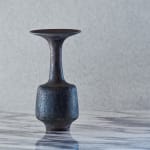Lucie Rie (1902–1995)
Vase
Ceramic
Marked “LR” on the bottom
W13 x H25 cm
One of the most versatile potters of the twentieth century, Lucie Rie always maintained a keen eye on the efficiency of a restraint aesthetic. The trumpet-shaped mouth of the vessel, a choice of form which over time has become a hallmark of her vases, contrasts with a slender neck that sharply transitions into the cylindrical body. A pattern of vertical incisions covers the body, setting its surface apart from the smoothness of the neck and mouth. Size and shape of this vase are similar to a Fluted Vase in the collection of the Crafts Study Centre of the University for the Creative Arts in Farnham (UK), dated 1970s, with some minor differences as for the bulge of the body and the size relationship between the body and the mouth. It is curious to note, however, how an almost identical shape can yield two vastly different impressions: while Fluted Vase uses an off-white “volcanic” glaze, the present Vase employs the manganese dioxide-based glaze that Rie over time developed to near-perfection, resulting in a dark-brown tone that creates a rustic appeal. Another variation of a similar shape, yet in a bulgier approach, shows an uneven off-white glaze and the same vertical incisions on the body (included in Lucie Rie: A Retrospective, The National Art Center Tokyo, 2010–11, cat. 155; private colllection, c. 1976).
The impact of Japanese and Chinese ceramics in Rie’s oeuvre of course is apparent, yet the overall range of her influences is eclectic and includes, for instance, Mycenaean and Islamic pottery, mid-twentieth century Scandinavian design and much of the aesthetic vocabulary of classical modernism. When Rie met Bernard Leach for the first time in 1939, she was already an up-and-coming star in the world of applied arts, having received the Gold Medal of the Brussels International Exposition in 1935, the Gold Medal of the Milan Triennial in 1936 and the Silver Medal of the Paris International Exposition of 1937. Descending from a Jewish family, she was forced to emigrate from her native Austria to England in 1938. After settling in London, she survived the dire war period by producing ceramic buttons and jewelry, resuming her more artistically challenging studio work once the political and economic situation stabilized again in the late 1940s. From 1946 onward, she maintained a lifelong working relationship with the German-born potter Hans Coper.
A few factors set Rie’s approach apart from other studio potters of her time, among those the fact that she relied on an electric kiln, allowing for highly controlled firing. Moreover, she would use brushed-on raw glazing, meaning that instead of firing first the body and another time the glaze the whole process would be done in a single firing, resulting in a glaze that fully integrated into the body of the object. The present Vase is a product of such techniques. The incision pattern is related to sgraffito, another device the artist often exploited for decorative effect and that is representative of her work.
Lucie Rie (potter; 1902–1995)
Born in Vienna, Rie studied ceramics under Michael Powolny at the School of Arts and Crafts in Vienna. After the German takeover of Austria, she emigrated to London in 1938, where she established a pottery studio near Hyde Park. Her early work shows the influence of Jugendstil, Neoclassicism and Japonism. Rie maintained a friendship with Bernard Leach, though in contrast to Leach her style relied on brightly colored, modernist aesthetics. She was awarded the title Dame Commander of the Order of the British Empire in 1991.
The impact of Japanese and Chinese ceramics in Rie’s oeuvre of course is apparent, yet the overall range of her influences is eclectic and includes, for instance, Mycenaean and Islamic pottery, mid-twentieth century Scandinavian design and much of the aesthetic vocabulary of classical modernism. When Rie met Bernard Leach for the first time in 1939, she was already an up-and-coming star in the world of applied arts, having received the Gold Medal of the Brussels International Exposition in 1935, the Gold Medal of the Milan Triennial in 1936 and the Silver Medal of the Paris International Exposition of 1937. Descending from a Jewish family, she was forced to emigrate from her native Austria to England in 1938. After settling in London, she survived the dire war period by producing ceramic buttons and jewelry, resuming her more artistically challenging studio work once the political and economic situation stabilized again in the late 1940s. From 1946 onward, she maintained a lifelong working relationship with the German-born potter Hans Coper.
A few factors set Rie’s approach apart from other studio potters of her time, among those the fact that she relied on an electric kiln, allowing for highly controlled firing. Moreover, she would use brushed-on raw glazing, meaning that instead of firing first the body and another time the glaze the whole process would be done in a single firing, resulting in a glaze that fully integrated into the body of the object. The present Vase is a product of such techniques. The incision pattern is related to sgraffito, another device the artist often exploited for decorative effect and that is representative of her work.
Lucie Rie (potter; 1902–1995)
Born in Vienna, Rie studied ceramics under Michael Powolny at the School of Arts and Crafts in Vienna. After the German takeover of Austria, she emigrated to London in 1938, where she established a pottery studio near Hyde Park. Her early work shows the influence of Jugendstil, Neoclassicism and Japonism. Rie maintained a friendship with Bernard Leach, though in contrast to Leach her style relied on brightly colored, modernist aesthetics. She was awarded the title Dame Commander of the Order of the British Empire in 1991.



